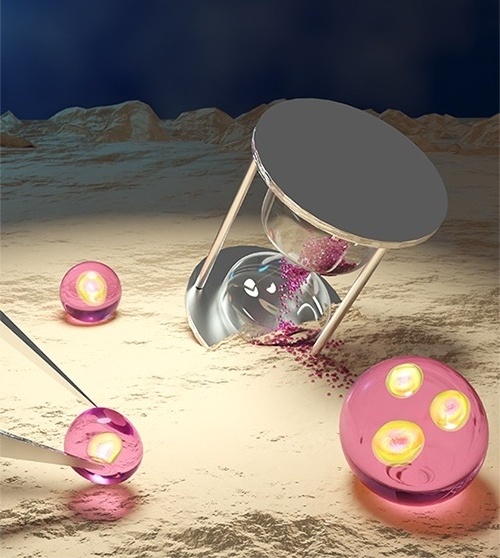- Home
- > Research
- > Research Highlights
- > Vol. 83 Novel “Drycell” Microdroplets ・・・
 Research Highlights
Research Highlights
[Vol. 83]
Novel “Drycell” Microdroplets to Make Handling a Single Cell Easier
Scientists at the Research Center for Materials Nanoarchitectonics (MANA) have developed micrometer-sized "liquid marbles" that can encapsulate single to several living cells, thereby aiding single-cell studies.
To analyze individual cells, the desired number of cells must be isolated spatially. This often requires extensive training and use of expensive laboratory equipment. MANA scientists have recently overcome this hurdle using nanotechnology. They coated cell-suspension microdroplets with superhydrophobic nanoparticles -- tiny particles that possess surfaces with exceptional water-repellent properties -- and created spherical structures known as "drycells," with customizable sizes ranging from one to several hundred micrometers, which can be handled and picked up with ease. This will make cell picking easier and greatly facilitate single-cell analysis.
To achieve this, the research team hand-sprayed suspended cells to create a cellular "mist." Upon coming into contact with a vibrating nanoparticle bed, the cell-containing mist droplets instantly got coated with superhydrophobic-fumed silica nanoparticles, thus producing liquid marble-like drycells with a dry powder-like outer layer surrounding an inner liquid core. In fact, the scientists could create drycells with >95% inner aqueous content surrounded by a dry outer layer. These droplets exhibited powder-like smooth flow and could easily be picked up with a pair of tweezers without suffering any damage or spilling the inner liquid. Moreover, the superhydrophobic silica nanoparticles in the surface coating prevented the droplets from merging.
The scientists could sort the drycells according to size through sieving. They were also able to simultaneously encapsulate normal and cancerous cells as well as creating several cell colonies inside these drycells. Further, they could introduce liquids into, as well as withdraw, the liquid from these droplets with ease. Finally, they observed that centrifugation could separate the nanoparticles from the cell-suspension layers, which makes the process recyclable.
"Our method of drycell production efficiently facilitates cell picking and lowers the barrier for single-cell studies and will greatly improve the accessibility and productivity of single-cell analysis," concludes Dr. Koichiro Uto, speaking on behalf of study co-authors Mizuki Tenjimbayashi and Shota Yamamoto.
To achieve this, the research team hand-sprayed suspended cells to create a cellular "mist." Upon coming into contact with a vibrating nanoparticle bed, the cell-containing mist droplets instantly got coated with superhydrophobic-fumed silica nanoparticles, thus producing liquid marble-like drycells with a dry powder-like outer layer surrounding an inner liquid core. In fact, the scientists could create drycells with >95% inner aqueous content surrounded by a dry outer layer. These droplets exhibited powder-like smooth flow and could easily be picked up with a pair of tweezers without suffering any damage or spilling the inner liquid. Moreover, the superhydrophobic silica nanoparticles in the surface coating prevented the droplets from merging.
The scientists could sort the drycells according to size through sieving. They were also able to simultaneously encapsulate normal and cancerous cells as well as creating several cell colonies inside these drycells. Further, they could introduce liquids into, as well as withdraw, the liquid from these droplets with ease. Finally, they observed that centrifugation could separate the nanoparticles from the cell-suspension layers, which makes the process recyclable.
"Our method of drycell production efficiently facilitates cell picking and lowers the barrier for single-cell studies and will greatly improve the accessibility and productivity of single-cell analysis," concludes Dr. Koichiro Uto, speaking on behalf of study co-authors Mizuki Tenjimbayashi and Shota Yamamoto.
Reference
“Drycells: Cell-Suspension Micro Liquid Marbles for Single-Cell Picking”
Mizuki Tenjimbayashi, Shota Yamamoto, and Koichiro Uto
Journal: Advanced Materials 2023 (July 27, 2023)
DOI : 10.1002/adma.202300486
Mizuki Tenjimbayashi, Shota Yamamoto, and Koichiro Uto
Journal: Advanced Materials 2023 (July 27, 2023)
DOI : 10.1002/adma.202300486
Affiliations
Research Center for Materials Nanoarchitectonics (MANA), National Institute for Materials Science (NIMS), Namiki 1-1, Tsukuba, Ibaraki 305-0044, Japan
Research Center for Macromolecules and Biomaterials, National Institute for Materials Science (NIMS), Namiki 1-1, Tsukuba, Ibaraki 305-0044, Japan
Contact information
Research Center for Materials Nanoarchitectonics (MANA)
National Institute for Materials Science
1-1 Namiki, Tsukuba, Ibaraki 305-0044 Japan
Phone: +81-29-860-4710
E-mail: mana-pr[AT]nims.go.jp
1-1 Namiki, Tsukuba, Ibaraki 305-0044 Japan
Phone: +81-29-860-4710
E-mail: mana-pr[AT]nims.go.jp


